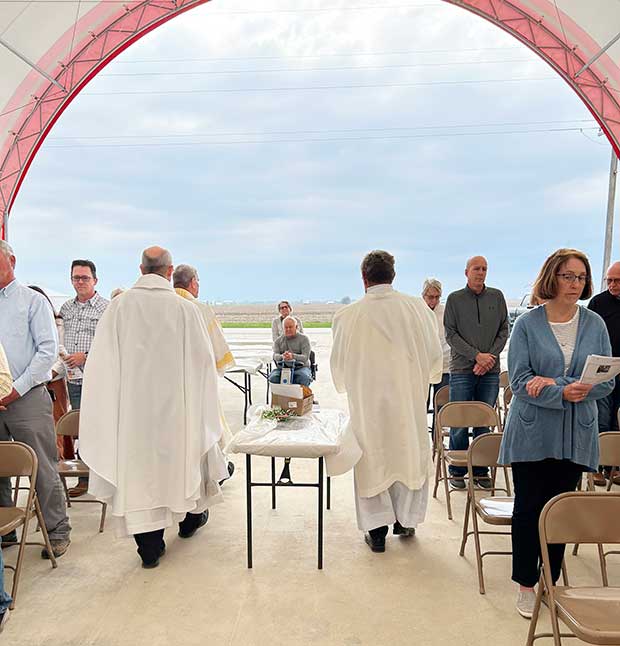
The hoop barn on the Pieper Farm in Donnellson served as the setting for Mass on the Farm and Blessing of the Seeds April 15. Father Dan Dorau presided at the Mass. The four parishes he leads in Lee and Van Buren counties collaborated.
By Barb Arland-Fye
The Catholic Messenger
Ninety years after Congress passed its first Farm Bill during the Great Depression, a new Farm Bill is being crafted that addresses agriculture, nutrition, the economy and the environment, among other issues of importance to all Americans. Authorized approximately every five years, the current $428 billion omnibus bill that covers 12 separate program titles is set to expire Sept. 30. Representing Iowa on the House and Senate agriculture committees working on the 2023 Farm Bill are U.S. Reps. Randy Feenstra and Zach Nunn and U.S. Sens. Charles Grassley and Joni Ernst.

“This is one of the largest pieces of legislation the Congress produces, and despite the name, it impacts a whole lot more than farms and farming communities,” says Glenn Leach, a volunteer with the Diocese of Davenport’s Social Action and Immigration offices. The Farm Bill “also includes domestic aid such as SNAP (formerly known as food stamps) and humanitarian aid such as Food for Peace… The leadership in the House of Representatives will be looking at the Farm Bill carefully as one of the pieces of legislation where they can make the spending reductions sought,” Leach added.
Kate Hansen, senior policy associate for the Center for Rural Affairs, provided a Farm Bill 101 presentation for participants of a webinar that Iowa Interfaith Power and Light organized on the topic June 29.
“Our goal is that the 2023 Farm Bill is one that truly reduces greenhouse gas emissions and provides broad environmental benefits while increasing equity and justice among those who produce food and agricultural goods and improving the lives of people in rural communities,” said Irene DeMaris, executive director of IIP&L.

Hansen was one of eight panelists on the webinar’s panel. She explained the meaning of an omnibus bill (many components contained in one package) and identified the 12 components of the current, 2018 Farm Bill.
The components are commodities; conservation; trade; nutrition (SNAP is the main nutrition component); credit (federal loan programs to help farmers access credit to sustain and grow their farm operations); rural development; research, extension and related matters; forestry; energy; horticulture; crop insurance; and miscellaneous. Based on projected funding for the current Farm Bill, the nutrition component makes up 76% of the current $428 billion Farm Bill; crop insurance, 9%; commodities, 7%; conservation, 7%; and other, 1% (source: National Sustainable Agriculture Coalition).
Each of the House and Senate agriculture committees drafts, amends and votes on its own version of the bill after which each full chamber debates, amends and votes on the bill from its respective committee. Leaders from the House and Senate, including the committee chairs, form a conference committee to combine the bills. The full chambers vote on the combined final bill and then it is sent to the White House for the president’s signature, according to the National Sustainable Agriculture Coalition (NSAC).
NSAC states that the first farm bills aimed “to keep food prices fair for farmers and consumers, ensure an adequate food supply, and protect and sustain the country’s vital resources.” These goals were in response to “the economic and environmental crises of the Great Depression and Dust Bowl.” Although the Farm Bill has changed through the years, “its primary goals are the same,” NSAC says. New challenges confront the nation’s food and farming system today, “but through citizen and stakeholder action for a fair farm bill, we can ensure the vibrancy and productivity of our agriculture, economy, and communities for generations to come.”
“Conservation, specifically on working agricultural lands, has remained a top priority for the Center for Rural Affairs,” Hansen says. “In addition to conserving valuable natural resources, such as water and soil, conservation practices implemented by producers offer risk management and economic benefits, particularly in the face of a changing climate.”
Other panelists on the IIP&L webinar were Aaron Lehman of Iowa Farmers Union, Michael Happ of the Institute for Agriculture and Trade Policy, Elston Tortuga of IIP&L, Hannah Breckbill of Humble Hands Harvest and Practical Farmers of Iowa, Sikowis Nobiss of Great Plains Action Society, Warren Varley of Pine View Angus Farms, and Denise O’Brien of Women Food and Agriculture Network.
“We need to build a local and regional food system,” Lehman said in his presentation. He also called for a “competition title” in the Farm Bill to ensure fair competition so that multinational corporations do no benefit at the expense of local farm operations.
Happ spoke about the various USDA conservation programs covered in the Farm Bill and the rejection many Iowa farmers experience in approval of their applications for the most popular programs.
O’Brien emphasized local food economies and sustainable foods availability. Iowa has a competitive edge pertaining to food production, water and transportation. Accessibility to land for future farmers is essential, she said. Sikowis Nobiss reiterated that point in her presentation. The Farm Bill should provide more aid for equity building, she said.











